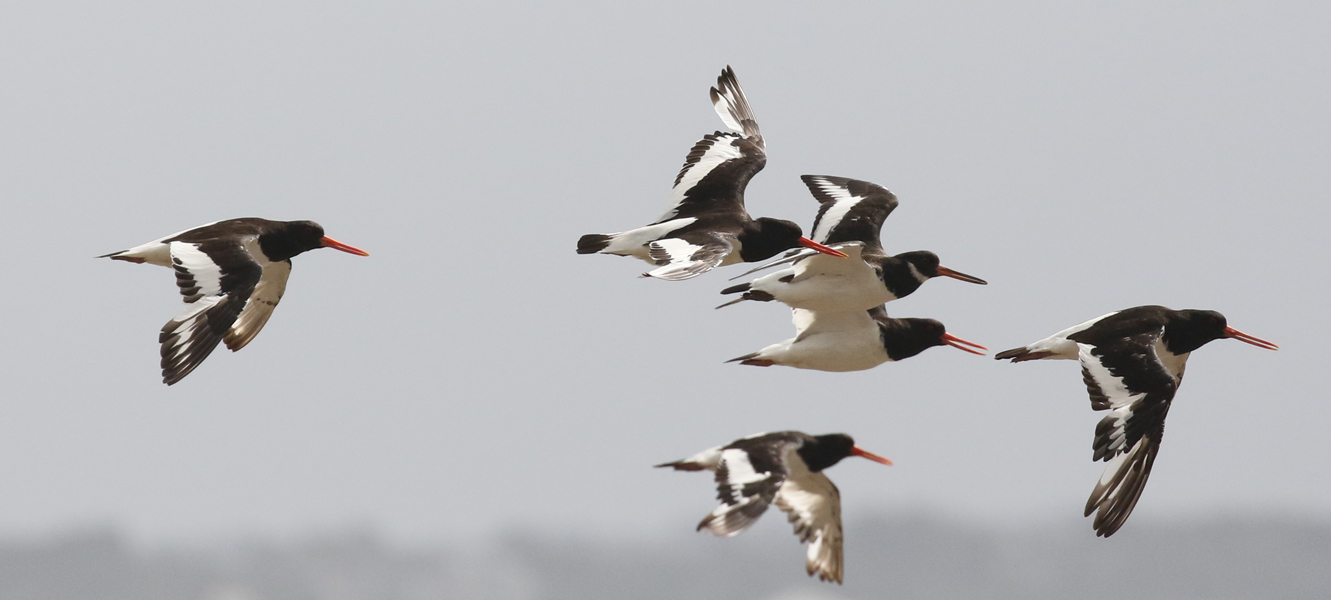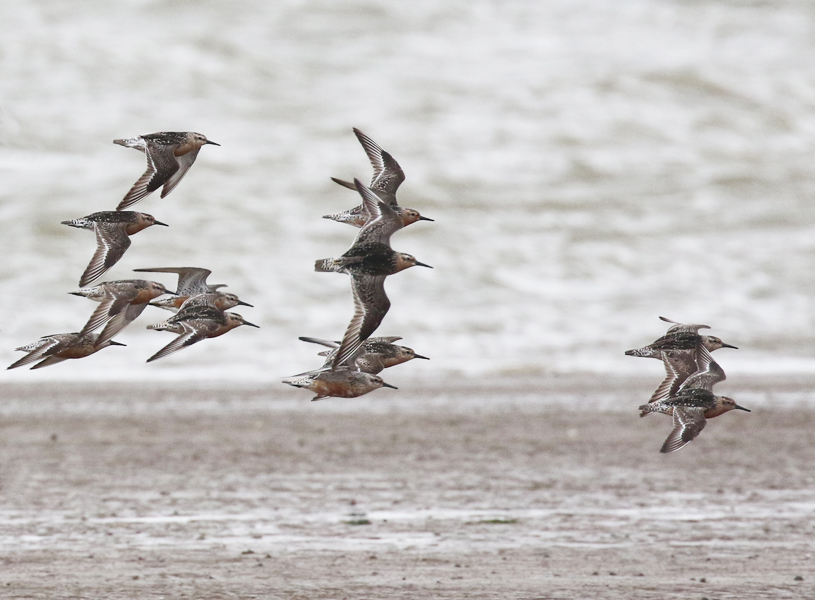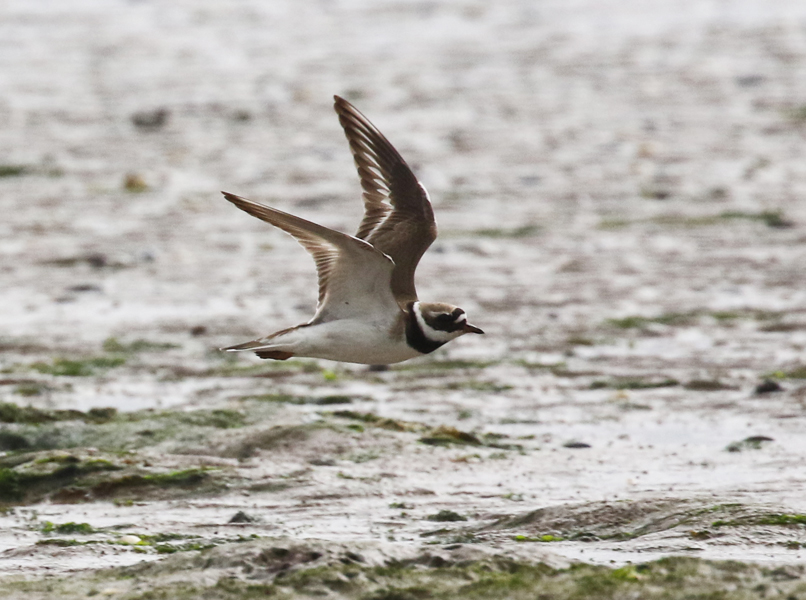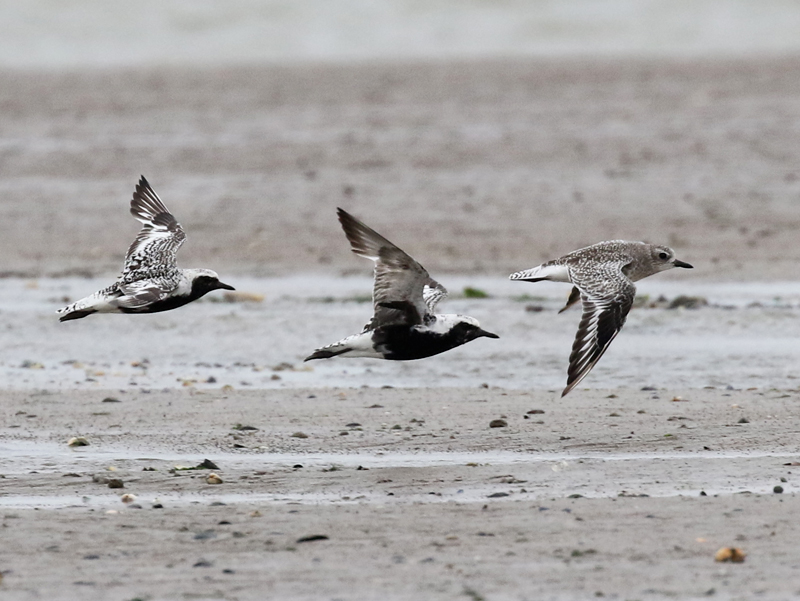
One of the most spectacular things in bird watching is seeing large numbers of birds together in the same place. When I am in UK there is one obvious place for me to head to in order to get a taste of this type of experience; the high tide roost at Shellness in North Kent. This location is part of a National Nature Reserve and consists of a shingle spit adjoining salt marsh and mud flats; a great place for viewing waders particularly as numbers start to build up at the end of August and into September. Recently I paid a visit to this location, less than an hour’s drive from my home town of Dartford, in rather grey and windy conditions that were not ideal for using a telescope or camera but by timing it right I was able to enjoy the spectacle of large numbers of waders flying past me at close range, to their high tide roost on the shingle ridge. The following are some of the better photos I got, despite the gloomy conditions, and you will notice that all the birds are flying from left to right as they head to the roost site.
Bar far the most obvious and numerous wader present at Shellness is Eurasian Oystercatcher. As well as being the most obvious in terms of its bold black and white plumage it is present in large, noisy numbers with up to 2000 birds present at peak numbers and even a few hundred present all year round. I really love these birds and as I stood out on the mudflats and group after group of Oystercatchers took off and flew directly towards me it was quite exciting. I have written about these birds before here – Eurasian Oystercatchers | Bird Behaviour – so for now a couple of photos will suffice.
The species of wader that is usually the next most abundant at this location is Black-tailed Godwit. A few hundred can usually be found here but there is a much large high tide roost for this species at nearby Oare Marshes. They make a nice subject for photography as they fly past and at this time of the year they have interesting moult patterns in their wings.
As can be seen from the light in the photo above, the grey skies were not exactly optimal for bird photography and the strong winds made it really hard for me to track the birds in flight in order to focus properly. When a flock of Red Knot passed through I was a little surprised at the numbers of them and with just one opportunity I wasn’t sure if I could get them in focus. I was lucky with a few nice shots, with this one below cropped to show a small part of the flock in detail.
One of the commoner and ever-present waders at Shellness is Common Ringed Plover, which actually breed on the beach. These small waders fly really quickly and in this poor light it was next to impossible to photogrph them but among all the blurry shots I got one which was an acceptable quality.
Other species of wader that I got awful photos of included Bar-tailed Godwits in partial breeding plumage, two Sanderling and several Dunlin but I did get some nice shots of a small group of Grey Plovers. Although some birds were moulting into winter plumage there were still some individuals in their summer colours; very smart indeed.
One species which was a little easier to photograph in these conditions was Eurasian Curlew. The stiff wind that they were flying into, combined with their flight feathers moulting meant that their flight was really slow, close to stalling at times, making it easier to track them with the camera. Judging by the relatively short bill of the bird in the photo below this individual is a male. I am used to seeing the orientalis subspecies of Eurasian Curlew, in Thailand, which has a far longer bill than the birds in Europe.
Of course the birds that join a high tide wader roost are not all waders. Several species of gulls are always present and Sandwich Terns breed in the area so they can always be seen at this time of the year. Photographing white birds can be difficult in bright light so the gloomy conditions actually made getting photographs that are not overexposed a bit easier.
While I had a good time photographing these birds in flight I had a terrible ending to my excursion. While I had my camera on a tripod, videoing some Turnstones, a dog walker came along with his dog running rampant off of the lead (in an area where there are many signs requesting that dogs be kept on leads to avoid disturbing the birds) and the dog crashed into me and knocked my camera into the puddles of sea water around my feet. This rendered the camera malfuctional and looking at a huge bill for repairs or replacement I had a heated discussion with a very rude person who just walked off towards his car.
With an expensive camera and lens wrecked because of seawater and a dreadful member of society the spectacle of the birds was somewhat overshadowed. However, Canon gave me advice over the phone of how best to preserve the camera and I took it to their repair workshop and they had it fixed and serviced within 5 days. Considering that travel restrictions have left me with no source of income for 5 months or the foreseeable future the repair bill is something I could have done without but I was given a discount on repairs and had the camera fixed very quickly. Thanks Canon for getting the camera quickly sorted out at a cost that was far lower than I had feared.
I will be back to Shellness soon to get some more wader photos and some video. Take a look at some previous posts with more photos taken at Shellness;


 August 30th, 2020
August 30th, 2020  Nick
Nick 








 Posted in
Posted in  Tags:
Tags: 










